Large-amplitude dust acoustic solitons in an opposite polarity dusty plasma with generalized polarization force
2022-01-23MahmoodKhaledMohamedShukriandYusraHager
Mahmood A.H.Khaled Mohamed A.Shukri and Yusra A.A.Hager
1Department of Physics,Faculty of Education(Al-Mahweet),Sana’a University,Sana’a,Yemen
2Department of Physics,Faculty of Science,Sana’a University,Sana’a,Yemen
3Department of Physics,Faculty of Education,Sana’a University,Sana’a,Yemen
Keywords: large amplitude,opposite polarity dusty plasma,polarization force
1. Introduction
After the theoretical prediction of the dust acoustic(DA)wave in a dusty plasma in the early 1990s by Raoet al.,[1]Barkanet al.[2]confirmed the existence of such a wave in laboratory plasmas. The DA wave is one of the fundamental collective excitations in dusty plasma composed of electrons,ions, and negatively charged dust particles. It is a very low frequency mode that arises due to the longitudinal dust oscillation resulting from the interplay of dust inertia,the screened electric field, and the background pressures of hot ions and electrons. Over the past three decades, a large number of works have been carried out to discuss various aspects of the linear and nonlinear propagation of DA waves in different dusty plasma systems.[3-8]Most of these studies focused on a three-component dusty plasma system comprised of electrons,ions and negatively charged dust particles. Although there are many observations in both space[9-12]and laboratory[13-15]plasmas that indicate the existence of both positively and negatively charged dust populations,it is well known that the presence of positively charged dust grains depends upon various charging mechanisms, such as secondary electron emission from dust grain surfaces,[16]ultraviolet photo-ionization,[17]and thermionic emission by radiative heating.[18]
It is noted that the coexistence of both positively and negatively charged dust in plasmas introduces a new dusty plasma model which is widely known as opposite polarity dusty plasma (OPDP).[19,20]This new field of dusty plasmas has attracted a lot of attention in recent years. However,most of the studies on DA waves in OPDP have focused on small-amplitude solitary waves in the framework of the reductive perturbation technique.[21-26]Actually, the perturbation technique is valid only for small-amplitude waves, but it is not suitable for large-amplitude solitary waves. In fact, large amplitude solitary waves can be studied analytically only by using non-perturbative methods; namely, the pseudopotential method of Sagdeev[27](which is also called the Sagdeev potential method).Chatterjee and Kundu[28]reported that a dusty plasma with an opposite polarity dust fluid and Boltzmann distributed ions admits both the rarefractive and compressive solitary waves associated with nonlinear large-amplitude DA waves. Verheestet al.[29]used the Sagdeev potential approach to investigate large amplitude DA solitary waves in a dusty plasma containing both cold and adiabatic negative/positive dust. They found that solitary waves can only occur for nonlinear structure velocities smaller than the adiabatic dust thermal velocity,leading to a novel dust-acoustic-like mode based on the interplay between the two dust species. Maharajet al.[30]studied large amplitude solitary waves in the framework of the Sagdeev potential approach in an opposite polarity dusty plasma comprised of a cold negative dust fluid,adiabatic positive dust fluid, Boltzmann electrons and nonthermal ions. They found that both rarefactive and compressive solitary waves existed. Ahmadet al.[31]discussed the essential features of arbitrary amplitude DA solitary waves by employing the Sagdeev potential approach in an adiabatic opposite polarity dusty plasma with vortex-like distributed electrons and ions. They found that the basic features of dustacoustic solitary structures are significantly modified due to the polarity of dust,the trapping of plasma particles(electrons and ions), and the temperatures of dust fluids. Abulwafaet al.[32]showed that both types of compressive and rarefactive DA solitons can coexist and propagate in a four-component dusty plasma system containing non-extensive electrons and ions as well as positively and negatively charged dust grains.They employed the Sagdeev potential and phase-portrait approaches. They found that the Mach number, non-extensive parameter and dust temperature ratio have constructive effects on the profile of dust acoustic solitons.
Actually, there are many forces acting on a massive charged dust grain embedded in a plasma. One of them is the polarization force,which arises due to any deformation in the Debye sheath around the dust grain in a background of nonuniform plasmas. Hamaguchi and Farouki[33,34]illustrated the concept of polarization force on the dust grain and its importance in a dusty plasma. The first introduction of the polarization force into the dust momentum equation was by Khrapaket al.[35]They investigated the propagation characteristic of a linear DA wave and mentioned that the polarization force has an important effect on the massive dust particles. It is noted that the effect of polarization force on small-amplitude DA solitary waves has attracted a lot of attention,[26,36-39]while few studies have focused on large-amplitude solitary waves in the framework of the Sagdeev potential approach. For example, Bandyopadhyayet al.[40]used the Sagdeev potential approach to investigate the effect of polarization force on largeamplitude DA solitary waves in a dusty plasma composed of negatively charged dust grains and Maxwellian distributed electrons and ions. They found that the presence of a polarization force leads to a decrease in the Mach number regime
where solitary structures can exist. El-Taibanyet al.[41]investigated the linear and nonlinear features of gravitoelectrostatic opposite polarity dusty plasma in the framework of the Sagdeev potential approach, taking into account the effect of polarization force on the negatively charged dust grains. They found that the real wave frequency is reduced by the presence of polarization force.Most of the above investigations focused only on the the limiting caseTe≫Ti, in which the Debye length approximated byλD≈λDiand the polarization force arises mainly due to the polarization of plasma ions around the negatively charged dust grain. Here,Te(Ti)is the electron(ion) temperature andλDiis the Debye length of ions. But this approximation is not congruous in general in an opposite polarity dusty plasma. Therefore, the major goal of the current paper is to examine the effect of generalized polarization force(which is valid to eitherTe≫TiorTe≪Ti)on the propagation regimes of the large-amplitude DA solitary waves in an opposite polarity dusty plasma system consisting of negatively and positively charged dust grains, electrons and ions obeying Maxwellian distribution,where the generalized polarization force is assumed to act on both negative and positive dust grains. In particular, we employ the Sagdeev potential approach to identify the dusty plasma parameters where the large-amplitude DA solitons occur and examine domains for which compressive and rarefactive solitary waves may exist.
The manuscript is organized as follows: The theoretical model containing the basic governing equations of plasma dynamics is described in Section 2. Section 3 is devoted to investigating linear DA waves and their related dispersion relation. The nonlinear large amplitude DA solitons are studied by using the Sagdeev potential approach in Section 4. Finally,conclusions are given in Section 5.
2. The theoretical model
We consider a collisionless, unmagnetized fourcomponent dusty plasma consisting of negatively and positively charged cold dust fluids in addition to Boltzmann distributed electrons and ions in the presence of the generalized polarization force acting on the massive charged dust grains(whether positive or negative). The number densities of electronsneand ionsnican be written as
whereρ=ne0/ni0represents the number density ratio of electron-to-ion andσi=Ti/Teis the temperature ratio of the ion-to-electron. UsingkBTe∇ne=ene∇φ, andkBTi∇ni=-eni∇φinto Eq.(6),the expression of the generalized polarization force can be written as

whereRd=Zde2/(16πε0kBTiλD0) is a parameter that determines the effect of the polarization force. Here,the subscriptddenotes the negatively charged dust grains (d=n) and the positively charged dust grains(d=p). It is clear from Eqs.(3)and (7) that the generalized polarization force is independent of a sign of dust charge. It is always in the direction of decreasing Debye length whether the dust charge is positive or negative.
For the limiting caseTene≫Tini,Eq.(7)tends toFpn≈-eZnRi(ni/ni0)1/2∇φ, which arises mainly due to the polarization of plasma ions around negatively charged dust whereRi=Zne2/(16πε0kBTiλDi0).On the other hand,ifTene≪Tini,Eq. (7) reduces toFpp≈eZpRe(ne/ne0)1/2∇φ, which arises mainly due to the polarization of plasma electrons around positively charged dust whereRe=Zpe2/(16πε0kBTeλDe0).Accordingly, the generalized expression of the polarization force (7) is valid for eitherTene≫TiniorTene≪Tini. In other words,our findings remain suitable for opposite polarity dusty plasma.
Since the condition whereby the potential perturbation is sufficiently small (i.e.,|eφ|≪kBTe,kBTi), we can expand the electron and ion densities given in Eqs. (1)and (2) by Taylor expansion aroundφ=0 asne/ne0=1+(eφ/kBTe)+(eφ/kBTe)2/2+···,ni/ni0= 1-(eφ/kBTi)+(eφ/kBTi)2/2+···, substituting these into Eq. (7), and after some calculations,the expansion of the polarization force can be expressed as
whereα1=(1-ρσ2i)/(1+ρσi), andP0=(α21-4α2)/2α1withα2=(1+ρσ3i)/2(1+ρσi). Here, we used|Qd|=Zde
whereZdis the number of charges residing on the dust grain surface. It is clear that for negatively charged dust grains,Rd=Rn=R=Zne2/16πε0kBTiλD0, whereRis a parameter determining the effects of the polarization force due to the interaction between plasma ions and negatively charged dust grains. On the other hand, for positively charged dust grains,Rd=Rp=Zpe2/16πε0kBTiλD0=ZR, which is a parameter determining the effects of the polarization force due to the interaction between plasma electrons and positively charged dust grains whereZ=Zp/Zn,andZp(Zn)is the number of the charges on the positive(negative)dust grain surface. Accordingly, the one-dimensional equations for positively and negatively charged dust grains are as follows:[26]

wherenn(np),un(up)andmn(mp)are the number density,the velocity, and the mass of the negatively (positively) charged dust grains, respectively, andP=Rα1. At equilibrium, the quasi-neutrality condition requiresZnnn0+ne0=Zpnp0+ni0,
wherenp0(nn0)is the equilibrium number density of positive(negative)dust.
3. Linear analysis
In order to study the dispersion properties of the linear DA waves from the basic Eqs.(9)-(13),we carry out the usual normal mode analysis. Accordingly,we expand the dependent variables(nn,np,un,upandφ)in terms of their equilibrium and perturbed parts asnn=nn0+nn1,np=np0+np1,un=0+un1,up=0+up1andφ=0+φ1. We assume that all perturbed quantities (nn1,np1,un1,up1,φ1) are proportional to ei(kx-ωt),whereωis the angular wave frequency andkis the wave number. Thus, substituting∂/∂t=-iωand∂/∂x= ikinto the linearized form of Eqs.(9)-(13),we obtain the following linear equations:Substituting Eqs. (19) and (20) into the linearized Poisson’s equation (18), and after simplification, we obtain the following linear dispersion relation:
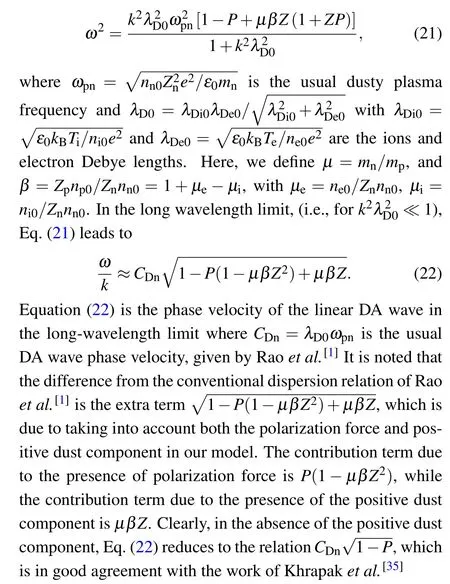
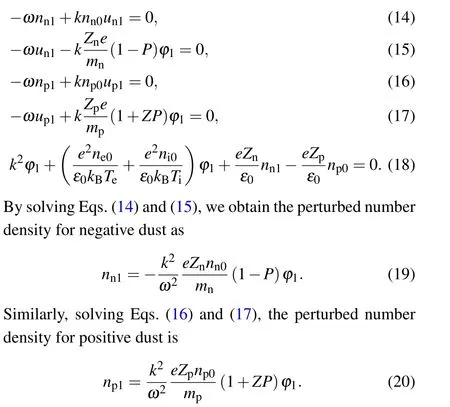

Fig.1. The linear dispersion relation for dust-acoustic waves for different values of polarization force parameter R. (a)is plotted for Z=0.2 and(b)is plotted for Z=0.01 whereµ=5,µi=0.7,µe=0.3,σi=0.2.
It is clear from Eq. (21) that the dispersion properties of the wave mode are modified by the polarization force parameter(R),the positive-to-negative dust charge number ratioZ(=Zp/Zn), and the negative-to-positive dust mass ratioµ(=mn/mp).These modified properties are displayed in Figs.1 and 2. As depicted in Fig.1,the dispersion relation is affected by the presence of polarization force. It is observed that the normalized wave frequency (ω/ωpn) increases with the increase of normalized wave number (kλD0), but it decreases with the polarization force parameter (R). The comparison between Figs. 1(a) and 1(b) shows that the normalized wave frequency increases asZincreases. The influence of the polarization force becomes weaker for larger values ofZ[see Fig.1(a)]. Figure 2 illustrates the normalized wave frequency(ω/ωpn)against the normalized wave number(kλD0)for different values ofµ. It is obvious that the normalized wave frequency increases with the increase of bothµandkλD0. This means that the large value ofµleads to the existence of DA waves with larger phase velocity.

Fig. 2. The linear dispersion relation for dust-acoustic waves for different values of µ where R=0.5, Z =0.2, µi =0.7, µe =0.3, and σi=0.2.
4. Nonlinear analysis
4.1. Derivation of the Sagdeev potential
To study the nonlinear propagation of large amplitude DA solitary waves in our dusty plasma model in the framework of the Sagdeev potential approach, it is more appropriate to normalize the various quantities in Eqs. (9)-(13)as follows:Nn=nn/nn0,Np=np/np0,Un=un/CDn,Up=up/CDn,φ=eφ/kBTi,T=tωpn,andX=x/λDn,whereCDn=(ZnkBTi/mn)1/2andλDn=(ε0kBTi/nn0Zne2)1/2are the DA velocity and Debye length,respectively.After the normalization,we obtain a dimensionless system of nonlinear equations. For their solutions, we assume that the dependent variablesX,Tdepend on a single independent variableη=X-MT,whereMis the Mach number(DA wave velocity/CDn).Then,we can express Eqs.(9)-(13)in terms of the normalized variables as

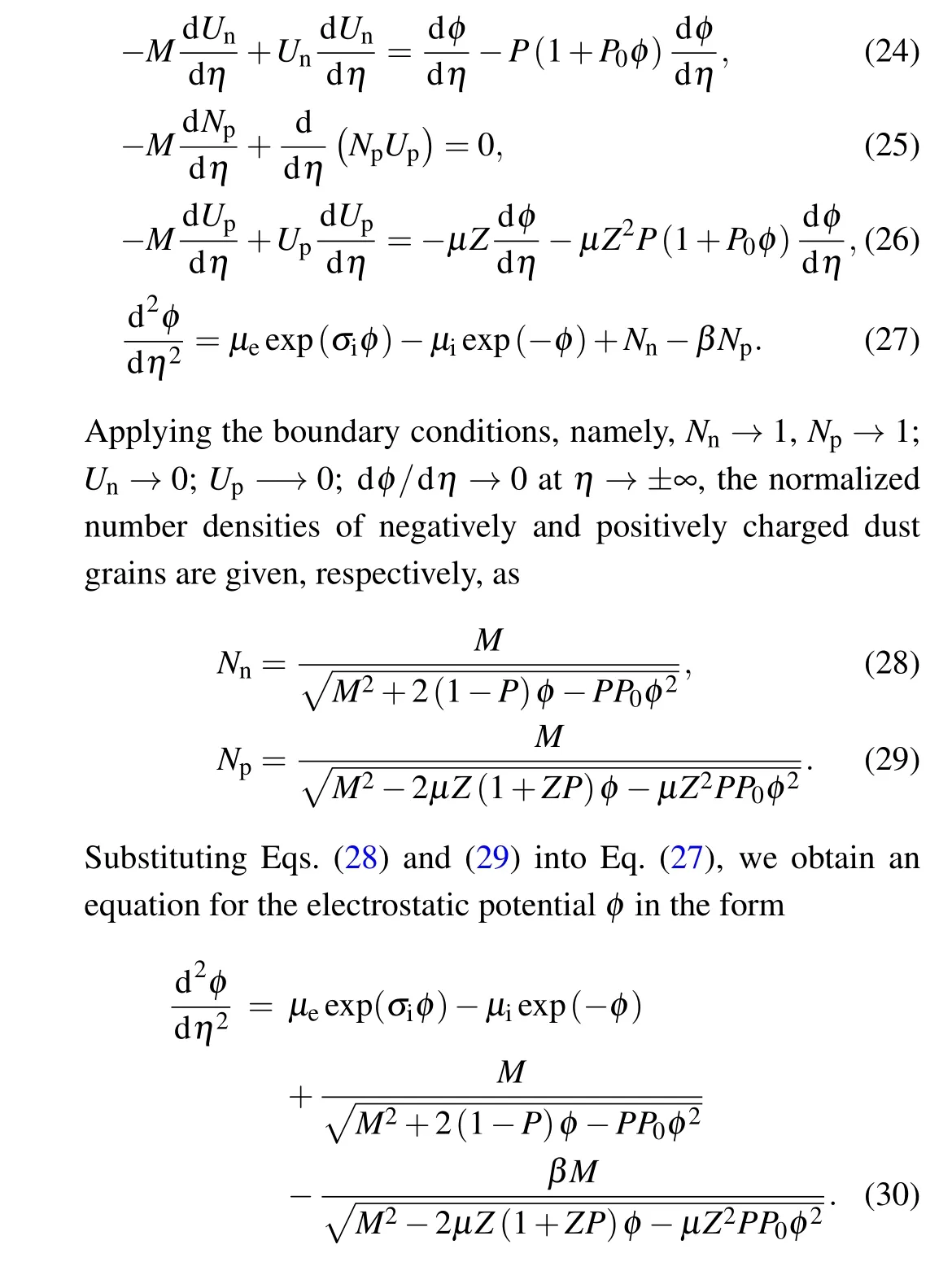
Multiplying both sides of Eq.(30)by dφ/dηand integrating once with respect toη, and taking into account the boundary conditions dφ/dη →0 andφ →0 asη →±∞, we get the following equation:

Equation (31) represents the form of an energy integral for an oscillating particle of unit mass, with pseudo-positionφ,pseudo-timeη, and pseudo-potential wellV(φ). Here, the mathematical expression for a pseudo-potential(or Sagdeev’s potential)V(φ)is given by

whereΛn=-PP0[M2+2(1-P)φ-PP0φ2] andΛp=-µPP0[M2-2µZ(1+ZP)φ-µZ2PP0φ2]. It can be noticed that the Sagdeev’s potentialV(φ) is significantly affected by the polarization force as well as other plasma parameters. In the absence of polarization force, i.e., in the limiting case(R →0),the Sagdeev potentialV(φ)is reduced to

which completely agrees with the result obtained by Chatterjee and Kundu.[27]
4.2. Existence conditions for DA solitons
The solitonic solutions of Eq. (31) exist only if the Sagdeev potential (32) satisfies the conditions: (i)V(φ)= dV(φ)/dφ=0, forφ=0; (ii) d2V(φ)/dφ2<0 atφ= 0, so that a maximum occurs at the origin (the fixed point at the origin is unstable); (iii)V(φ)< 0 forφlying between 0 andφm. In the interval 0<φ<φm, compressive solitons(i.e., positive potential solitons)exist. In the intervalφm<φ<0, rarefactive solitons (i.e., negative potential solitons)exist. Here,φmis the amplitude of the solitary wave or soliton.
Equation(32)indicates that condition(i)is always satisfied. For the second condition(ii),we can obtain

In order for the local maximum condition to be satisfied at the origin,viz. [d2V(φ)/dφ2]φ=0<0,one requiresM>Mcr,whereMcris the critical Mach number(the minimum value ofMat which the soliton amplitude goes to zero or the value ofMat which the second derivative changes its sign).The critical Mach numberMcrcan be calculated from Eq.(34)as

This gives the lower limit on the range of Mach numbers that allows DA solitons to exist.
Figure 3 shows how the critical Mach numberMcris modified by the polarization force parameter (R) and the charge number ratio(Z). From this figure,we determine thatMcrdecreases (increases) with the increase inR(Z). ForZ=0.01,the critical Mach numberMcr<1 for all values ofR>0.35,while forZ=0.2, the critical Mach numberMcr>1 for all values ofR. Physically,Mcr< 1 means that the existence of subsonic (M< 1) DA solitons is possible in our model,
whereas supersonic (M>1) DA solitons are admissible forMcr>1. Furthermore, we found that in the absence of polarization force (asR=0), which forZis taken asZ=0.01 orZ=0.2, DA solitons can only exist with higher values of(M>1)(i.e.,supersonic DA solitons exist). Now,if we consider the limiting case forZ=0 orβ=0(i.e.,in the absence of a positively charged dust component),Eq.(35)leads to

which agrees with Bandyopadhyayet al.[40]

Fig. 3. Variation of the critical Mach number Mcr with polarization force parameter R for two different values of Z whereµ =5, µi=0.7,µe=0.3,σi=0.2.
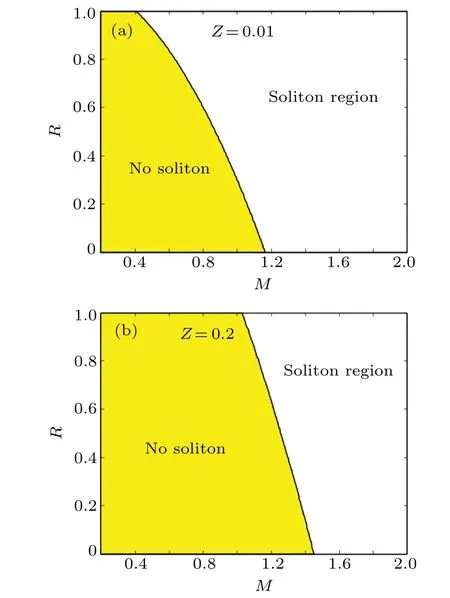
Fig. 4. Contour plots showing the existence regions of DA solitons in space(M,R). (a)is plotted for Z=0.01 and(b)is plotted for Z=0.2 whereµ =5,µi=0.7,µe=0.3,and σi=0.2.
The contour of the condition (34) in the space (M,R) is plotted in Fig. 4. This figure shows the regions of existence of DA solitons in the space (M,R) for two different values ofZ. Figure 4(a) is plotted forZ=0.01, while Fig. 4(b) is plotted forZ=0.2. It is noted that the curveS(M)=0 (in whichM=Mcr) divides the space (M,R) into two areas, one on the left of the curve, in whichS(M)>0, and the other on the right of the curve whereS(M)<0. It shows that the soliton solutions of Eq.(31)exist at the right region of the curves in whichS(M)<0. But in the left region,in whichS(M)>0,the soliton solutions of Eq. (31) do not exist. Furthermore,Figs. 4(a) and 4(b) show that the value ofZhas a significant effect on the admissible range of the Mach number for which DA solitons occur. It is clear from Fig.4(a)that,forZ=0.01(i.e., for lower value of the charge number of positive dust),localized soliton structures can propagate forM>1.16 whenR=0. It can also be seen from Fig.4(a)that the region of the existence domain of DA solitons increases with the increased values ofR, and forR ≥0.3, the region of the existence domain of subsonic DA solitons is possible. On the other hand,whenZ=0.2,the region of the existence domain of DA solitons becomes narrower,as shown in Fig.4(b).This means that when the contribution of the positive dust component (viaZ)is enhanced,only supersonic solitons can exist.

Fig. 5. A profile of the Sagdeev potential V(φ) versus φ in the absence of polarization force(via R=0)where M=1.4,Z=0.1,µ =5,µi=0.7,µe=0.3,and σi=0.2.
Figure 5 depicts a profile of the Sagdeev potential curveV(φ)versus the electrostatic potentialφin the absence of the polarization force effect[i.e.,whenR=0,andV(φ)given in Eq.(33)]with the consideration of the typical dusty plasma parameters,namely,M=1.4,Z=0.1,µi=0.7,µe=0.3,µ=5,andσi=0.2. It is obvious from this figure that the Sagdeev potentialV(φ) has a negative value in the interval ofφ=0 toφ=φ1with one side ending on a maximum and the other side just crossing the zero value ofV(φ). This will produce a compressive-type soliton. In the other region, forφ=φ2fromφ2toφ=0, a rarefactive soliton is produced. The potential well created in the positiveφ-axis is deeper than those created in the negativeφ-axis. This means that the amplitude(width)of the rarefactive soliton is lower(higher)than that of the compressive soliton.
The influence of polarization force (viaR= 0.2) on a Sagdeev potential profileV(φ) (which is determined by Eq. (32)) is shown in Fig. 6 with the same values of dusty plasma parameters as Fig.5. From this figure we observe that Sagdeev potential wells are formed in both the positive and negativeφ-axes,i.e.,the compressive and rarefactive DA solitons coexist. Due to the presence of polarization force, the potential well formed in the negativeφ-axis is very deep in comparison with that formed in the positiveφ-axis. From a comparison between Figs.5 and 6,one can also see that,for a fixed value ofM=1.4,the presence of polarization force leads to an increase (a decrease) of the amplitude (width) for both compressive and rarefactive DA solitons, as shown in Fig. 6.The presence of polarization force has a profound effect on the rarefactive solitons compared with compressive solitons.
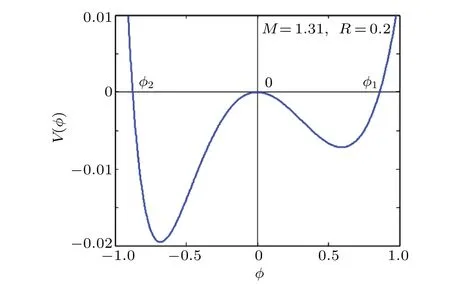
Fig. 6. A profile of the Sagdeev potential V(φ) versus φ in the presence of polarization force(via R=0.2)where M=1.4,Z=0.1,µ=5,µi=0.7,µe=0.3,and σi=0.2.
In addition, there is also another condition determining the criterion for the existence of compressive and rarefactive solitons used in a number of investigations.[20,24]This condition requires that the dusty plasmas would support rarefactive(compressive)DA solitons if d3V(φ)/dφ3<0(>0)forφ=0,andM=Mcr.

whereF(Mcr) determines the criterion for the existence of compressive or rarefactive solitons, i.e., ifF(Mcr)< 0, the soliton solution of Eq.(31)corresponds to rarefactive solitons.On the other hand,whenF(Mcr)>0,Eq.(31)is solved only for compressive solitons. Figure 7 shows the contour plot of the existence domain region of compressive or rarefactive DA solitons. Figure 7(a) is plotted without a polarization force(viaR=0), and Fig. 7(b) is plotted with a polarization force(viaR=0.5) forµe=0.3,µ=5, andσi=0.2. From these figures, we can see that both positive and negative potential solitons can create in our dusty plasma model. The potential profile is negative(i.e.,the appearance of rarefactive solitons)on the left of the curve ofF(Mcr)=0, in whichF(Mcr)<0,and positive (i.e., the appearance of compressive solitons) on the right of the curve whereF(Mcr)>0. Due to the presence of the polarization force effect,the compressive soliton region becomes wider,while the rarefactive soliton region shrinks(as shown in Fig.7(b)).
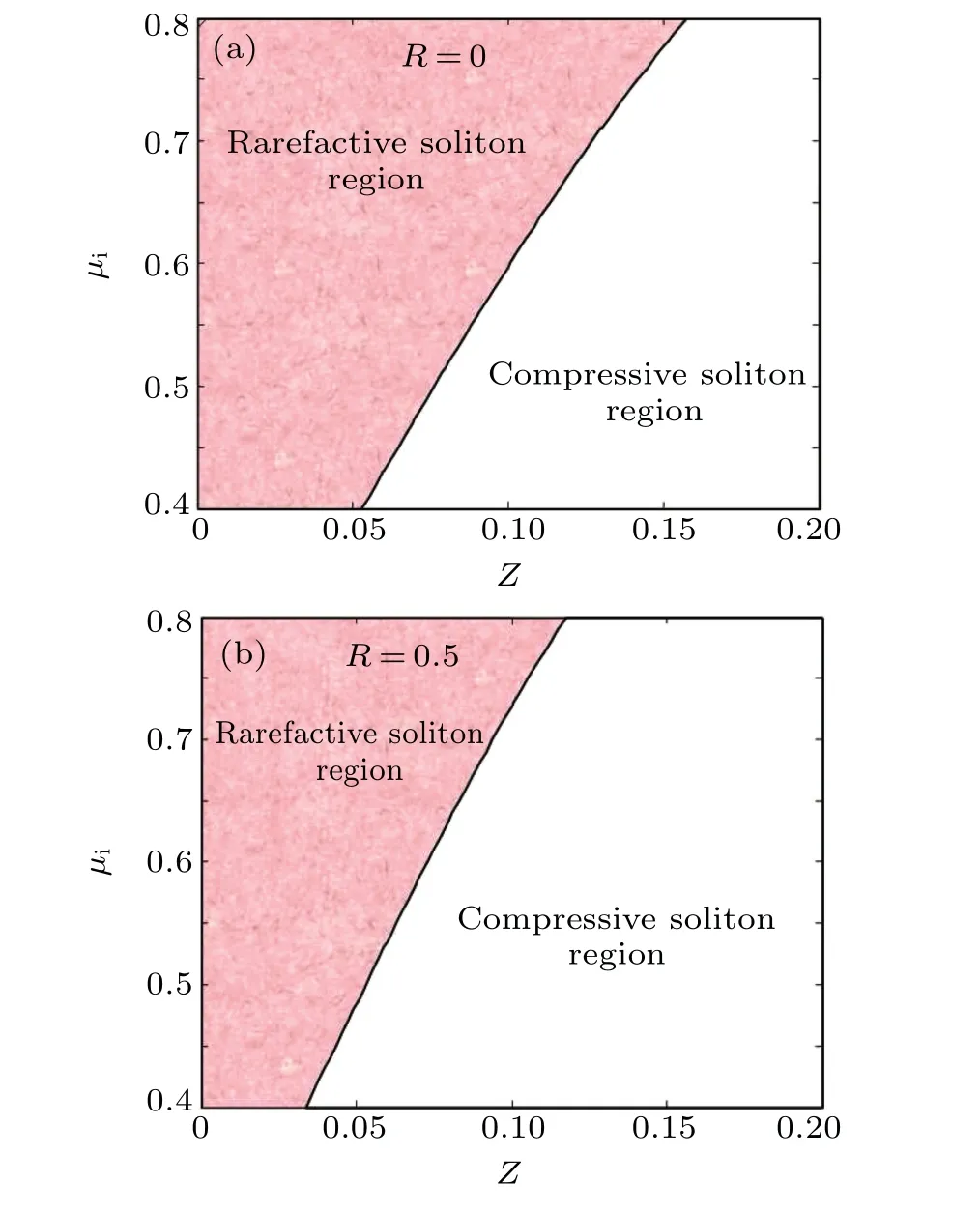
Fig. 7. Contour plot showing the region of the existence domain of compressive or rarefactive DA solitons in space(Z,µi). (a)is plotted in the absence of polarization force (via R=0); and (b) is plotted in the presence of polarization force(via R=0.5)whereµ=5,µe=0.3,and σi=0.2.
Figure 8 illustrates the variation of the Sagdeev potential curves against the negativeφ-axis, without polarization force[i.e.,whenR=0,andV(φ)is given by Eq.(33)],for different values of Mach numberM. It is clear from this figure that forZ=0.01,and whenMexceeds the value ofMcrwhich isMcr=1.1464,only rarefactive solitons are formed in the supersonic region with a Mach number rangeMcr Fig. 8. Behavior of the Sagdeev potential V(φ) versus φ for different values of M when M exceeds Mcr =1.1464 where Z =0.01, R=0,µi=0.7,µe=0.3,µ =5,and σi=0.2. Fig.10. Behavior of the Sagdeev potential V(φ)versus φ for different values of M when M exceeds Mcr =1.3678 where Z =0.2, R=0.5,µi=0.7,µe=0.3,µ =5,and σi=0.2. Fig. 9. Behavior of the Sagdeev potential V(φ) versus φ for different values of M when M exceeds Mcr =0.8717 where Z =0.01, R=0.5,µi=0.7,µe=0.3,µ =5,and σi=0.2. The formation of potential wells in the positiveφ-axis,which corresponds to the formation of compressive DA solitons for different values ofMand for large values ofZ=0.2,is displayed in Fig.10.Here,the Sagdeev’s potentialV(φ)corresponds to Eq.(32)with the dusty plasma parameters:Z=0.2,R=0.2,µi=0.7,µe=0.3,µ=5,σi=0.2, andMexceedsMcr=1.3678. It is evident that compressive DA solitons are formed in the Mach number range 1.5≤M ≤1.76.Physically,this means that only supersonic DA solitons can exist in such plasmas. This figure also indicates that the amplitude of compressive DA solitons increases with the increased values ofM,while their width reduces. On the other hand,the effect of the polarization force parameter (viaR) on the formation of Sagdeev potential wells in the positiveφ-axis is illustrated in Fig.11 when the Machnumber is taken asM=1.6 and other plasma parameters areZ= 0.2,µi= 0.7,µe= 0.3,µ= 5, andσi= 0.2. It can be noted that the depth and width of the Sagdeev potential wells increase with an increase in the polarization force (as Fig.11. Behavior of the Sagdeev potential V(φ)versus φ for different values of R where M =1.6, µi =0.7, µe =0.3, µ =5, and σi =0.2,and Z=0.2. By including the effect of generalized polarization force,the linear and nonlinear properties of the DA waves in an opposite polarity dusty plasma system consisting of positively charged dust grains,negatively charged dust grains and Maxwellian electrons and ions are studied. The linear dispersion relation of a DA wave has been derived. An energy integral equation involving the Sagdeev potential,which describes large amplitude DA solitons, has been obtained by using the Sagdeev potential approach. The analysis of the Sagdeev potential indicates that both the rarefractive and compressive DA solitons can form in our dusty plasmas model. The effects of the dusty plasma parameters,such as the polarization force parameterR, the ratio of the charge number of positive dust to that of negative dustZand the Mach numberM, on the Sagdeev potential profile have been examined. For large polarization force with a lower value ofZ=0.01, large amplitude DA solitons can exist in the subsonic regime(M<1)or supersonic regime (M>1), whilst in the absence of the polarization force effect, our results demonstrate the possibility of the propagation of DA solitons in the supersonic regime.We have also found that the effect of the polarization force makes the electrostatic solitary structures spikier. Moreover,it has been found that the presence of the positive dust component does not only significantly modify the basic properties of the electrostatic solitary potential structures,but also causes the coexistence of the positive and negative solitary potential structures. Finally, the parameters that we have chosen in our numerical analysis are relevant to different regions of space,viz.,cometary tails,mesosphere,and Jupiter magnetosphere.[11,12]Thus,the results of this paper would be useful in understanding the basic nonlinear feature of DA wave propagation in space dusty plasmas, especially those including polarization force.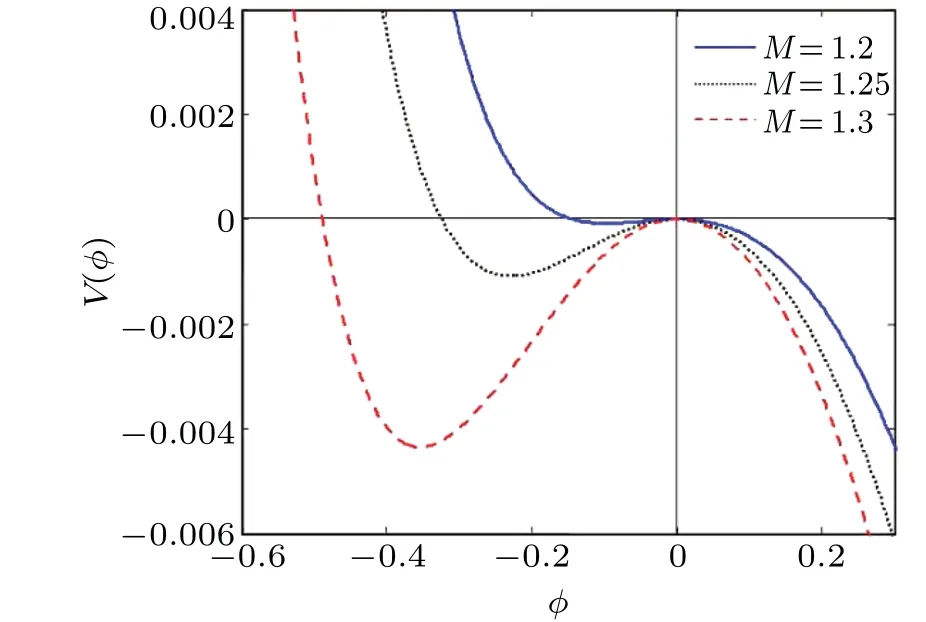


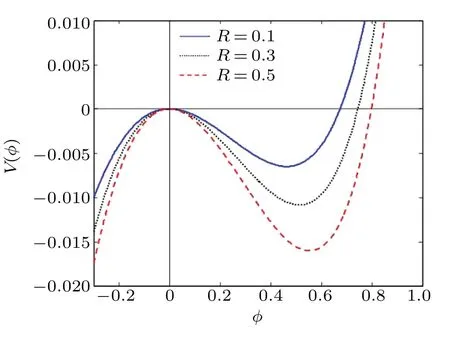
5. Conclusion
杂志排行
Chinese Physics B的其它文章
- Superconductivity in octagraphene
- Soliton molecules and asymmetric solitons of the extended Lax equation via velocity resonance
- Theoretical study of(e,2e)triple differential cross sections of pyrimidine and tetrahydrofurfuryl alcohol molecules using multi-center distorted-wave method
- Protection of entanglement between two V-atoms in a multi-cavity coupling system
- Semi-quantum private comparison protocol of size relation with d-dimensional GHZ states
- Probing the magnetization switching with in-plane magnetic anisotropy through field-modified magnetoresistance measurement
